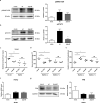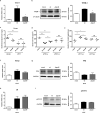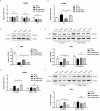Salmonella effector SpvB aggravates dysregulation of systemic iron metabolism via modulating the hepcidin-ferroportin axis
- PMID: 33475464
- PMCID: PMC7833757
- DOI: 10.1080/19490976.2020.1849996
Salmonella effector SpvB aggravates dysregulation of systemic iron metabolism via modulating the hepcidin-ferroportin axis
Abstract
Iron withholding, an essential component of nutritional immunity, plays a fundamental role in host resistance to Salmonella infection. Our previous study showed that SpvB, an important pSLT-encoded cytotoxic effector, facilitated Salmonella pathogenesis within macrophages via perturbing cellular iron metabolism. However, the underlying mechanisms of SpvB in Salmonella-relevant disorders of systemic iron metabolism have not yet been identified. Here, we demonstrated that SpvB facilitated Salmonella to scavenge iron from the host by modulating the hepcidin-ferroportin axis, a key regulator of systemic iron metabolism. We observed that SpvB enhanced hepatic hepcidin synthesis in a STAT3-dependent manner, but not the BMP/SMAD pathway. This subsequently resulted in a reduction of the unique cellular iron exporter ferroportin, which facilitated hypoferremia and hepatic iron accumulation and ultimately countered the limitation of iron availability, thereby improving the chances of Salmonella survival and replication. Moreover, SpvB promoted the production of proinflammatory molecules associated with the infiltration of inflammatory cells via highly upregulating TREM-1 signaling. Our data supported a role of TREM-1 in SpvB-related dysregulation of host iron metabolism and suggested that targeting TREM-1 might provide a potential therapeutic strategy to prevent or alleviate Salmonella pathogenesis.
Keywords: Salmonella; SpvB; systemic iron metabolism; TREM-1; hepcidin–ferroportin axis.
Figures








Similar articles
-
Salmonella effector SpvB interferes with intracellular iron homeostasis via regulation of transcription factor NRF2.FASEB J. 2019 Dec;33(12):13450-13464. doi: 10.1096/fj.201900883RR. Epub 2019 Sep 30. FASEB J. 2019. PMID: 31569998
-
Inverse agonist of estrogen-related receptor γ controls Salmonella typhimurium infection by modulating host iron homeostasis.Nat Med. 2014 Apr;20(4):419-24. doi: 10.1038/nm.3483. Epub 2014 Mar 23. Nat Med. 2014. PMID: 24658075
-
Salmonella plasmid virulence gene spvB enhances bacterial virulence by inhibiting autophagy in a zebrafish infection model.Fish Shellfish Immunol. 2016 Feb;49:252-9. doi: 10.1016/j.fsi.2015.12.033. Epub 2015 Dec 23. Fish Shellfish Immunol. 2016. PMID: 26723267
-
Hepcidin-ferroportin axis in health and disease.Vitam Horm. 2019;110:17-45. doi: 10.1016/bs.vh.2019.01.002. Epub 2019 Feb 8. Vitam Horm. 2019. PMID: 30798811 Free PMC article. Review.
-
Hepcidin-Ferroportin Interaction Controls Systemic Iron Homeostasis.Int J Mol Sci. 2021 Jun 17;22(12):6493. doi: 10.3390/ijms22126493. Int J Mol Sci. 2021. PMID: 34204327 Free PMC article. Review.
Cited by
-
Comprehensive profiling of serotypes, antimicrobial resistance and virulence of Salmonella isolates from food animals in China, 2015-2021.Front Microbiol. 2023 Apr 4;14:1133241. doi: 10.3389/fmicb.2023.1133241. eCollection 2023. Front Microbiol. 2023. PMID: 37082181 Free PMC article.
-
Lactobacillus johnsonii L531 Ameliorates Salmonella enterica Serovar Typhimurium Diarrhea by Modulating Iron Homeostasis and Oxidative Stress via the IRP2 Pathway.Nutrients. 2023 Feb 23;15(5):1127. doi: 10.3390/nu15051127. Nutrients. 2023. PMID: 36904126 Free PMC article.
-
NLRP6 induces RIP1 kinase-dependent necroptosis via TAK1-mediated p38MAPK/MK2 phosphorylation in S. typhimurium infection.iScience. 2024 Feb 28;27(4):109339. doi: 10.1016/j.isci.2024.109339. eCollection 2024 Apr 19. iScience. 2024. PMID: 38500819 Free PMC article.
-
Sepsis‑induced cardiac dysfunction and pathogenetic mechanisms (Review).Mol Med Rep. 2023 Dec;28(6):227. doi: 10.3892/mmr.2023.13114. Epub 2023 Oct 20. Mol Med Rep. 2023. PMID: 37859613 Free PMC article. Review.
-
SaaS sRNA promotes the interfering effect of Salmonella on hepatic iron metabolism via modulating ferroportin 1.iScience. 2024 Dec 20;28(2):111660. doi: 10.1016/j.isci.2024.111660. eCollection 2025 Feb 21. iScience. 2024. PMID: 39935453 Free PMC article.
References
Publication types
MeSH terms
Substances
LinkOut - more resources
Full Text Sources
Other Literature Sources
Medical
Miscellaneous
